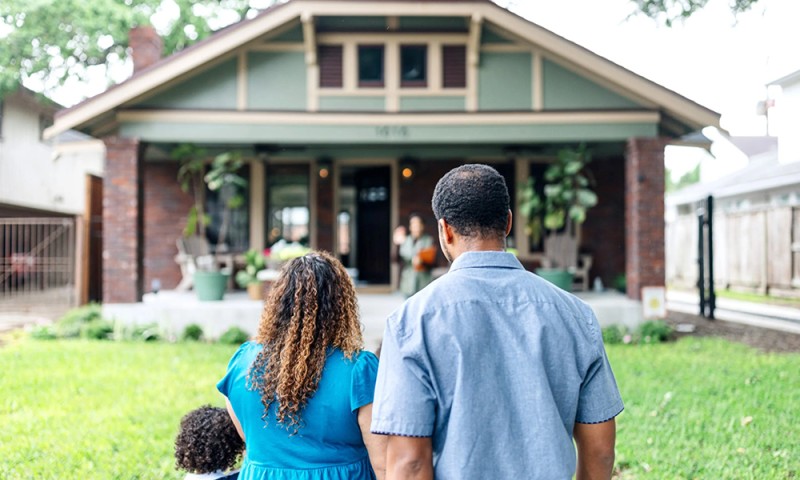
• 2025年,美国住房可负担性略有改善,原因是抵押贷款利率呈下降趋势,且部分市场房价涨幅趋于平缓或出现回落——尽管当前市场环境仍比疫情前严峻得多。第一美国金融公司(First American)的分析显示,住房可负担性同比提升3.1%。然而,对大多数美国人而言,购房仍面临挑战。
《财富》美国500强金融服务公司第一美国金融公司表示,在美国购房者多年深陷住房负担能力危机后,住房市场“终于开始倾听(购房者的声音)”。
多年来,高抵押贷款利率与高房价始终让购房者望而却步,尤其是疫情后的住房市场——疫情期间抵押贷款利率曾低于3%,房价也更为亲民。但自那以后,抵押贷款利率飙升,在2023年末达到8%的峰值。
过去数月里,抵押贷款利率略有下降——目前徘徊在6.5%左右——部分购房者至少获得些许喘息空间。与此同时,据全美房屋建造协会(National Association of Home Builders)称,受需求下降与供应增加影响,房价涨幅基本保持平稳或略有回落。
“对于一直持观望态度的潜在购房者而言,住房市场终于开始倾听他们的声音了。”第一美国金融公司首席经济学家马克·弗莱明(Mark Fleming)在8月29日的文章中写道。
弗莱明的分析基于该公司的“实际房价指数”(Real House Price Index,简称RHPI),该指数因纳入通胀因素而区别于其他房价指数。第一美国金融公司解释称,这是因为“和其他商品与服务一样,当下同一套房子的价格无法直接与三十年前的价格进行比较”。
若查看多数其他房价指数,会发现房价大幅上涨;但第一美国金融公司的数据显示,6月全美住房可负担性同比提升3.1%,这已是该指标连续第五个月实现年度增长。
但若参考凯斯-席勒房价指数(Case-Shiller Home Price Index),则会发现当前房价较五年前高出近50%。
此外,实际房价指数与其他房价指数的差异还体现在:它衡量的是“消费者购买力随时间推移产生的变化”(将收入与利率变动的影响纳入考量),而凯斯-席勒房价指数等指数追踪的则是“房价随时间推移发生的价值变化”。
住房可负担性确实改善了吗?
第一美国金融公司指出,当前存在一些积极迹象表明住房可负担性正在改善:抵押贷款利率略有下降、房价涨幅放缓、家庭收入有所提升。该公司的分析显示,当前住房可负担性已达到2024年9月以来的最佳水平。
该机构数据显示,全美超半数主要都市区房价下跌或年增长率低于1%,约70%市场的收入增速超过房价涨幅。其中奥斯汀跌幅最为显著,较2022年6月峰值下跌13%;旧金山较2022年4月峰值下跌10%。
弗莱明写道:“尽管卖家可能感受到定价能力减弱带来的压力,但房价涨幅放缓,再加上收入增长,终于为购房者带来了迫切需要的优势。”
不过,以实际房价指数衡量,当前住房可负担性仍比疫情前五年均值高出70%以上(即住房负担能力恶化)。
事实上,Redfin上周三发布的另一份分析显示,美国房主数量近十年首次停止增长,原因是即便抵押贷款利率与房价略有改善,但对大多数人而言,房价仍难以承受。
Redfin首席经济研究员赵晨(Chen Zhao,音译)指出:“美国房主数量停止增长,原因是房价不断上涨、抵押贷款利率居高不下以及经济不确定性,使购房难度持续攀升。人们结婚和组建家庭的时间推迟,这意味着购房时间也随之延后——这可能是造成这一现象的另一影响因素。”
但弗莱明指出,即便只是小幅改善,对潜在购房者而言,也不失为“积极信号”。美国房地产市场的修正过程将是渐进且不均衡的,“但趋势正在转变”。要达成这一转变,需收入持续增长、房价涨幅持续放缓以及抵押贷款利率下降共同作用。其他经济学家指出,要让美国住房重新变得可负担,所需的抵押贷款利率降幅“极不现实”,在部分大都市区,即便抵押贷款利率降至零也无法解决住房可负担性问题。
弗莱明写道:“尽管这一过程需要时间(可能要历经数年之久),但市场力量的天平已不再像房地产热潮期(疫情期间)那样严重失衡、彻底一边倒。”(*)
译者:中慧言-王芳
• 2025年,美国住房可负担性略有改善,原因是抵押贷款利率呈下降趋势,且部分市场房价涨幅趋于平缓或出现回落——尽管当前市场环境仍比疫情前严峻得多。第一美国金融公司(First American)的分析显示,住房可负担性同比提升3.1%。然而,对大多数美国人而言,购房仍面临挑战。
《财富》美国500强金融服务公司第一美国金融公司表示,在美国购房者多年深陷住房负担能力危机后,住房市场“终于开始倾听(购房者的声音)”。
多年来,高抵押贷款利率与高房价始终让购房者望而却步,尤其是疫情后的住房市场——疫情期间抵押贷款利率曾低于3%,房价也更为亲民。但自那以后,抵押贷款利率飙升,在2023年末达到8%的峰值。
过去数月里,抵押贷款利率略有下降——目前徘徊在6.5%左右——部分购房者至少获得些许喘息空间。与此同时,据全美房屋建造协会(National Association of Home Builders)称,受需求下降与供应增加影响,房价涨幅基本保持平稳或略有回落。
“对于一直持观望态度的潜在购房者而言,住房市场终于开始倾听他们的声音了。”第一美国金融公司首席经济学家马克·弗莱明(Mark Fleming)在8月29日的文章中写道。
弗莱明的分析基于该公司的“实际房价指数”(Real House Price Index,简称RHPI),该指数因纳入通胀因素而区别于其他房价指数。第一美国金融公司解释称,这是因为“和其他商品与服务一样,当下同一套房子的价格无法直接与三十年前的价格进行比较”。
若查看多数其他房价指数,会发现房价大幅上涨;但第一美国金融公司的数据显示,6月全美住房可负担性同比提升3.1%,这已是该指标连续第五个月实现年度增长。
但若参考凯斯-席勒房价指数(Case-Shiller Home Price Index),则会发现当前房价较五年前高出近50%。
此外,实际房价指数与其他房价指数的差异还体现在:它衡量的是“消费者购买力随时间推移产生的变化”(将收入与利率变动的影响纳入考量),而凯斯-席勒房价指数等指数追踪的则是“房价随时间推移发生的价值变化”。
住房可负担性确实改善了吗?
第一美国金融公司指出,当前存在一些积极迹象表明住房可负担性正在改善:抵押贷款利率略有下降、房价涨幅放缓、家庭收入有所提升。该公司的分析显示,当前住房可负担性已达到2024年9月以来的最佳水平。
该机构数据显示,全美超半数主要都市区房价下跌或年增长率低于1%,约70%市场的收入增速超过房价涨幅。其中奥斯汀跌幅最为显著,较2022年6月峰值下跌13%;旧金山较2022年4月峰值下跌10%。
弗莱明写道:“尽管卖家可能感受到定价能力减弱带来的压力,但房价涨幅放缓,再加上收入增长,终于为购房者带来了迫切需要的优势。”
不过,以实际房价指数衡量,当前住房可负担性仍比疫情前五年均值高出70%以上(即住房负担能力恶化)。
事实上,Redfin上周三发布的另一份分析显示,美国房主数量近十年首次停止增长,原因是即便抵押贷款利率与房价略有改善,但对大多数人而言,房价仍难以承受。
Redfin首席经济研究员赵晨(Chen Zhao,音译)指出:“美国房主数量停止增长,原因是房价不断上涨、抵押贷款利率居高不下以及经济不确定性,使购房难度持续攀升。人们结婚和组建家庭的时间推迟,这意味着购房时间也随之延后——这可能是造成这一现象的另一影响因素。”
但弗莱明指出,即便只是小幅改善,对潜在购房者而言,也不失为“积极信号”。美国房地产市场的修正过程将是渐进且不均衡的,“但趋势正在转变”。要达成这一转变,需收入持续增长、房价涨幅持续放缓以及抵押贷款利率下降共同作用。其他经济学家指出,要让美国住房重新变得可负担,所需的抵押贷款利率降幅“极不现实”,在部分大都市区,即便抵押贷款利率降至零也无法解决住房可负担性问题。
弗莱明写道:“尽管这一过程需要时间(可能要历经数年之久),但市场力量的天平已不再像房地产热潮期(疫情期间)那样严重失衡、彻底一边倒。”(*)
译者:中慧言-王芳
• Housing affordability in the U.S. has improved slightly in 2025 due to mortgage rates trending down and home price growth flattening or declining in some markets, though conditions are still much more difficult than before the pandemic. A First American analysis shows a 3.1% year-over-year gain in affordability. However, most Americans still find homeownership challenging.
After years of affordability challenges for buyers in the U.S., the housing market is “finally starting to listen,” according to Fortune 500 financial services firm First American.
High mortgage rates and home prices sidelined homebuyers for years, especially in the aftermath of the pandemic housing market that saw sub-3% mortgage rates and more affordable home prices. But ever since then, mortgage rates spiked, peaking at 8% in late 2023.
Now that mortgage rates are trending slightly lower during the past few months—currently hovering around 6.5%—some buyers have at least a little bit of breathing room. Meanwhile, home price growth is mostly flat or slightly declining because of decreasing demand and increasing supply, according to the National Association of Home Builders.
“For prospective buyers who have been waiting on the sidelines, the housing market is finally starting to listen,” wrote chief economist Mark Fleming in an Aug. 29 First American post.
Fleming’s analysis is based on First American’s Real House Price Index (RHPI), which stands out because it accounts for inflation, unlike other home-price indexes. That’s because “just like other goods and services, the price of a house today is not directly comparable to the price of that same house 30 years ago,” according to First American.
While a glance at most other home-price indexes would show a stark increase in home prices, First American’s actually shows national housing affordability rose 3.1% year over year in June, marking the fifth consecutive month with an annual gain.
However, if one were to look at something like the Case-Shiller Home Price Index, it would show home prices are nearly 50% higher than they were five years ago.
The RHPI also differs from other pricing indexes because it measures consumer buying power over time (taking into account the impact of income and interest rate changes), while other indexes like Case-Shiller track home value changes over time.
Is housing really becoming more affordable?
There are some promising signs housing affordability is improving: Mortgage rates are slightly declining, home-price growth is slowing, and household incomes are somewhat increasing, according to First American. That has led housing affordability to the best point it’s been since September 2024, First American’s analysis shows.
Home prices either declined or grew less than 1% annually in more than half of major U.S. metros, and income outpaced home-price appreciation in about 70% of markets, according to First American. Austin saw the sharpest decline at 13% from its June 2022 peak and San Francisco at 10% down from its April 2022 peak.
“While sellers may feel the pinch of waning pricing power, slower price growth—paired with rising incomes—is finally giving buyers a much-needed edge,” Fleming wrote.
Still, housing affordability, as measured by RHPI, remains more than 70% higher (worse) than the pre-pandemic five-year average.
Indeed, another analysis, published by Redfin on Wednesday, shows the U.S. homeowner population actually stopped growing for the first time in nearly a decade because mortgage rates and home prices still feel out of reach, even if they’re considered to be slightly improving.
“America’s homeowner population is no longer growing because rising home prices, high mortgage rates, and economic uncertainty have made it increasingly difficult to own a home,” wrote Chen Zhao, Redfin’s head of economics research. “People are also getting married and starting families later, which means they’re buying homes later—another factor that may be at play.”
But even a slight rebound can still be considered “an encouraging sign” for potential buyers, Fleming wrote. It’s going to be a more gradual and uneven leveling process for the U.S. housing market, “but the momentum is turning.” It will take more income growth, continued slowing of home price appreciation, and a drop in mortgage rates. Other economists have said the mortgage rate drop it would take to make housing feel affordable in the U.S. again is “unrealistic,” and in some metros even a 0% mortgage rate wouldn’t fix housing affordability.
“While this process will take time, likely years, the balance of power is no longer as one-sided as it was during the pandemic frenzy,” Fleming wrote.

